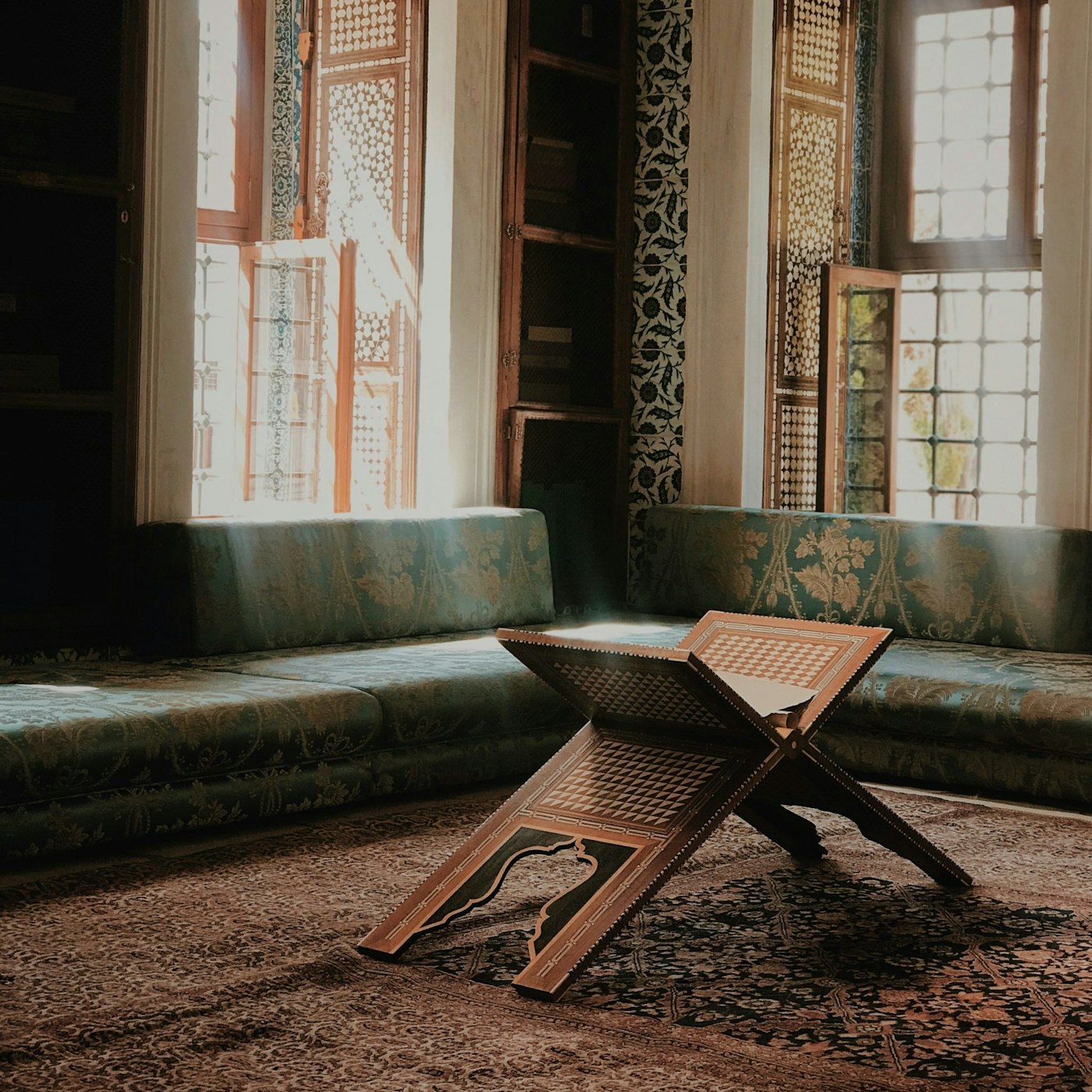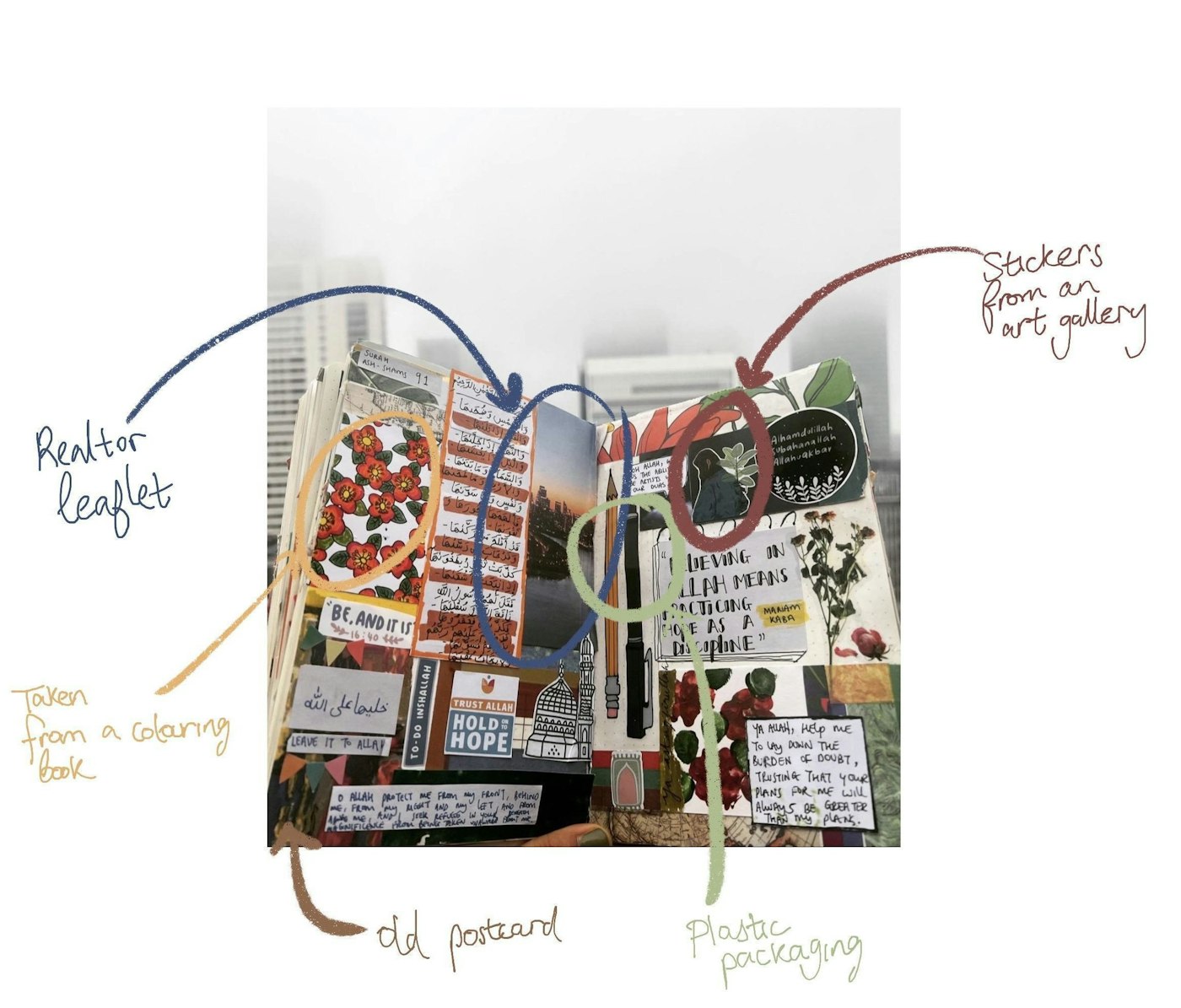A Guide to Cultivating Muraqabah Through Creative Journaling
by Sidra Malik in Culture & Lifestyle on 12th October, 2023

Mindfulness, known as muraqabah, is employed as an Islamic methodology where a person watches over their heart and soul. It is framed as a form of metacognition (an “awareness of one’s awareness”) to develop greater attention and care for our actions, thoughts, feelings and inner states of being (Parrot, 2017). The significance of mindfulness is underscored in Surah al-Baqarah, verse 235 where Allah commands believers to be conscious of their souls.
وَٱعْلَمُوٓا۟ أَنَّ ٱللَّهَ يَعْلَمُ مَا فِىٓ أَنفُسِكُمْ
“And remember that God knows what is in your souls, so be mindful of Him.” (Surah Al-Baqarah 2:235)
Muraqabah is linked to various names of Allah, including the Watcher (Ar-Raqib), the Guardian (Al-Hafith), the Knowing (Al-‘Aleem), the All-Seeing (Al-Basir) and the All Hearing (As-Sami’).
Scholars have proposed that muraqabah relates to achieving ihsan (goodness and excellence) where Prophet Muhammad ﷺ has described ihsan as “to worship Allah as if you see Him, and if you do not achieve this state of devotion, then (take it for granted that) Allah sees you” (Sahih al Bukhari).
The meaning of this hadith is the definition of muraqabah: to achieve ihsan, is to practise muraqabah in observing our souls for the sake of Allah. There are different spiritual practices that the scholar Al-Ghazali recommended for muraqabah including du’a, dhikr, and reading the Qur’an (qira’at).
My personal approach to engaging in muraqabah revolves around Qur’an journaling. My journey into Qur’an journaling began unexpectedly during the pandemic when I was sorting through our family shed and found an old colouring book featuring the different names of Allah. At the time, I was listening to weekly virtual halaqas that explored the meanings and significance of these divine names. I decided to use the colouring book as a starting point for my journaling: I traced out the names of Allah from the colouring book and documented what I had learned from each session.
As time went on, I wanted to strengthen my connection with the Qur’an – this led to a more proactive approach to my journaling practice: I began to select random ayah, reading translations and trying to relate them to the names of Allah that I had been studying. It was during these moments of reflection, that I would make heartfelt du’as, asking Allah to help me expand my ibadah.
The act of journaling allows me to manifest muraqabah through the written expression of du’as, dhikr, and a connection with the Qur’an, channelled in a creative manner. My approach centres around utilising easily accessible materials such as leaflets, paper/plastic bags, and repurposing childhood artwork. This means that I can infuse my daily routine with spiritual reminders that resonate with Allah’s presence. This method not only ensures a sustainable approach where I don’t need to buy materials but can look around my surroundings and reuse what I find, making my entries personal and encouraging mindfulness on a daily basis.
Qur’an journaling has become an expansive practice of muraqabah for me. I’ve realised that I can use this creative outlet to express and document my emotions, explore various themes that resonated with my personal experiences and growth, all while maintaining a strong connection to the Qur’an. It has become a holistic and deeply personal approach to self-expression and spiritual growth that incorporates artistic elements with the teachings of the Qur’an, hadith, and du’a making – ultimately, an introspective form of ibadah.
A Guide to Cultivating Muraqabah through Creative Journaling
1. Set your intentions. What do you hope to achieve through cultivating muraqabah in your life? How much of a journaling page do you aim to fill (one corner of a page, two or more?) By setting a realistic aim, the blank pages will hopefully seem less daunting.
2. Create a quiet space for your journaling practice. Not all of us have a space to ourselves so aim to create a corner of the room, a (lap) desk that can be designated to practising muraqabah. Surround yourselves with items that connect you with Allah, such as a set of dhikr beads and your copy of the Qur’an (with a translation in your native language).
3. Choose your materials. Journaling materials can include a notebook, pens, coloured pencils and any other art supplies that you’re drawn to. I find myself collecting bits and pieces as a form of memory-building, each piece relating to my evolving relationship with Allah. I use leaflets and postcards of holidays or fun days out with loved ones. SubhanAllah, the most basic of materials, can serve as powerful reminders of my spiritual journey. I particularly enjoy experimenting with different mediums, such as paints and pens, to create various textures and visual representations that resonate with me.The act of choosing your tools mindfully can set the tone for your creative exploration.

4. Begin with bismillah. This simple act of muraqabah helps centre your intentions on journaling.
5. Reflect on Quranic ayat. This can be chosen randomly or can be a favourite. Take your time in reading the translation and absorbing the meaning. What lessons can be drawn from it? How does it resonate with your experiences? Does it mention one of the names of Allah or remind you of any of Allah’s attributes?
One Qur’anic verse that is particularly meaningful to me is:
وَإِلَى ٱللَّهِ ٱلْمَصِيرُ
“And unto Allah is the journeying”. (Surah Ali ‘Imran 3:28)
I see this journey in how I navigate my relationship with Allah through mindful ibadah, as I enter different phases of my life. It encourages me to be mindful of Allah’s presence in every aspect of my life and reinforces the idea that my journey is ultimately directed towards Allah.
6. Express artistically and through words. Explore prompts to encourage reflections such as “How do I relate this material to the aya(t)?” and “Where was I in my relationship with Allah at the time I found this material?” and “What emotions and/or feelings do these materials invoke?”
7. Embrace imperfections and work through any pessimistic thoughts. In the beginning, looking at a blank journal made me feel very overwhelmed – what if I can’t finish the journal? To overcome this worry, I would pick random pages within the journal to begin entries. This way, when I flipped through my journal, I encountered entries scattered across different locations, creating a sense of progression and growth rather than a daunting expanse of empty pages. It made the journaling process more manageable and less intimidating.
As I continued to journal, I struggled with out-doing each journal entry. During these moments of self-doubt, I remind myself to go back to my intentions of wanting to connect with the Qur’an and engage in mindful practices in a creative way. Therefore, the way the journal entries look like at the end does not matter – it’s the act of mindful ibadah that I am prioritising and praying for Allah to accept.
8. Reflect on your entries. How have any emotions enriched your relationship with Allah and the Qur’an?
9. Share and connect with your loved ones to encourage critical conversations on cultivating your relationship with Allah. I have been able to connect with family and friends through mindful journaling; where my loved ones will bring materials that they resonate with and remind them of Allah. My younger cousin will use materials from her art GCSE; another will use a leaflet of a gallery they liked whilst on holiday. They look at patterns and motifs and we talk about where they were with their relationship with Allah at that time. The materials act as a physical reminder that our relationship with Allah is constantly in motion and dependent on what practices we can put in place to deepen and expand, as we continue to grow.
10. Conclude each journaling session with a small note of gratitude. Make a du’a to Al Musawwir (The Fashioner) to help you cultivate muraqabah through journaling and encourage further readings of the Qur’an.
Creativity can be infused with faith to engage mindfully and meaningfully with ibadah. The end result could be a journal filled with personal memories, your journey with deen and the overall creative approach to practising muraqabah. Having a mindful activity such as journaling reminds me of the importance of solitude when delving into deen. Although I have come to journal with others, I still prioritise journaling alone, reading the Qur’an and hadith and reflecting critically on my soul.
It reminds me of how Prophet Muhammad ﷺ would sit in solitude in Cave Hira, where he would receive the revelation of Islam. Or how Prophet Ibrahim عليه السلام isolated himself from his people when they practised idolatry, reflecting and seeking out Allah. These reflective periods were critical in developing their prophethoods, in developing their relationships with Allah and understanding how to articulate their iman.
Having an activity where I can practise muraqabah in solitude is therefore important to me in how I can articulate my iman to myself in a creative outlet, making it personal with the materials I reuse and the experiences I express, through Quranic journaling, reflecting my way back to Allah.
References
- Al-Ghazzālī, Iḥyā’ ’Ulūm Al-Dīn, 1:337
- Al-Muṣṭafawī, Ḥasan (1995). Al-Taḥqīq fī Kalimāt al-Qurʾān al-Karīm (in Arabic). Vol. 4 (1st ed.). Tehran: Wizārah al-Thiqāfah wa al-ʿirshād al-ʿislāmī. pp. 200–204
- Ibn Qayyim al-Jawzīyah, Madārij Al-Sālikīn, 2:66.
- Parrott, J. (2017) How to be a mindful Muslim: An exercise in Islamic meditation, Yaqeen Institute for Islamic Research. (Accessed: 16 September 2023).
- Sahih al-Bukhari, no. 4777, bk. 65, hadith. 299. Available at: https://sunnah.com/bukhari:4777
Sidra Malik
Salaams, my name is Sidra, I am 25 years old and I love to Quran journal, boxing and enjoy canal walks with coffees and pastries. You can find me on IG @mahfoozrakhna